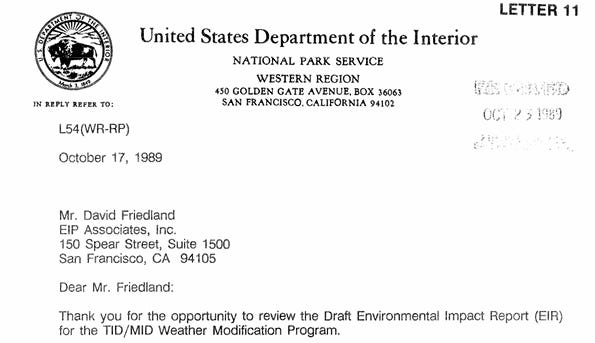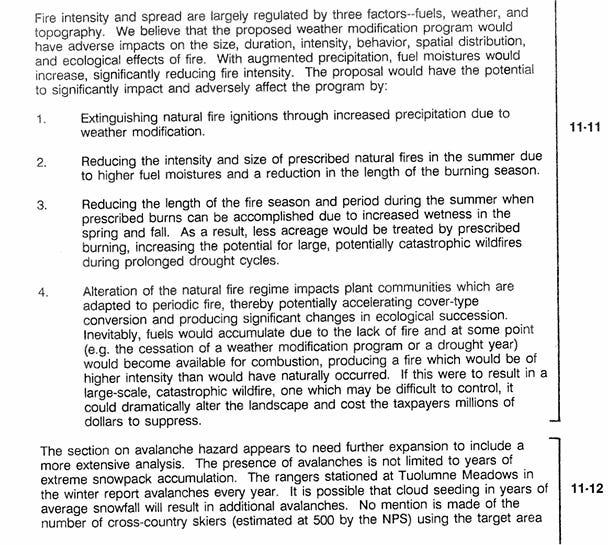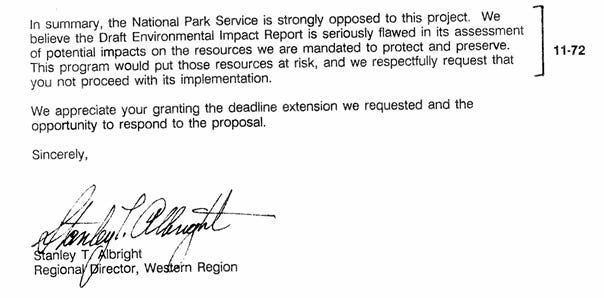The recent Idaho Department of Water resources board update on cloud seeding noted the California CEQA findings with regard to environmental impacts of the proposed cloud seeding program. In reviewing the comments provided by various groups at the conclusion of the report, it was clear that opposition was strong and warnings prescient. I would like to reiterate these warnings and call attention to the specific cautions in potential fire risks. Were we warned about possible fire stressors in cloud seeding impacts 35 years ago?
United States Department of the Interior
NATIONAL PARK SERVICE
Stanley T. Albright, Regional Director, Western Region
October 17, 1989
The EIR fails to mention the potentially significant adverse impacts to the wildland fire management program--both the prescribed fire and wildfire suppression operations. Abundant literature and research have recognized the role and function of fire in Yosemite National Park. Natural fire (lightning-caused) is a dominating process in Sierra Nevada ecosystems. Since the prescribed fire program began in 1970, more than 47,000 acres have directly benefited from the process of prescribed natural fire in the wilderness of Yosemite National Park. Twenty-seven thousand acres have been treated through prescribed burning. The acres burned have perpetuated the important role of fire in the ecosystem while reducing accumulations of hazardous wildland fuels.
Fire intensity and spread are largely regulated by three factors - fuels, weather, and topography. We believe that the proposed weather modification program would have adverse impacts on the size, duration, intensity, behavior, spatial distribution, and ecological effects of fire. With augmented precipitation, fuel moistures would increase, significantly reducing fire intensity. The proposal would have the potential to significantly impact and adversely affect the program by:
Extinguishing natural fire ignitions through increased precipitation due to
weather modification.
Reducing the intensity and size of prescribed natural fires in the summer due to higher fuel moistures and a reduction in the length of the burning season.
Reducing the length of the fire season and period during the summer when
prescribed burns can be accomplished due to increased wetness in the
spring and fall. As a result, less acreage would be treated by prescribed burning, increasing the potential for large, potentially catastrophic wildfires
during prolonged drought cycles.
Alteration of the natural fire regime impacts plant communities which are
adapted to periodic fire, thereby potentially accelerating cover-type conversion and producing significant changes in ecological succession. Inevitably, fuels would accumulate due to the lack of fire and at some point (e.g. the cessation of a weather modification program or a drought year) would become available for combustion, producing a fire which would be of higher intensity than would have naturally occurred. If this were to result in a large-scale, catastrophic wildfire, one which may be difficult to control, it could dramatically alter the landscape and cost the taxpayers millions of
dollars to suppress.
(emphasis mine)
Hmm…have we had “catastrophic wildfire” in recent history?
Are cloud seeding programs suppressing natural fire ignitions, reducing prescribed burn effectiveness, shortening the fire season, disrupting ecological succession/reducing biodiversity, and increasing future fire risks? Which department is evaluating this?
The commenter continues with concerns in accumulation levels.
The 'considerable uncertainty’ about cloud seeding is a primary basis for our opposition. We believe this uncertainty is, in itself, reason not to proceed with the program.
Since "silver iodide is the seeding material, and silver is toxic to man and mammals," and "localized concentrations of silver could be higher than average for the area," causing "potential for long-term accumulations in lake and meadow sediments," impacts would be significant. In addition, we have strong concerns about the "potential for photochemical decomposition of silver iodide, development of unanticipated organic forms of silver, unexpected chemical synergistic and antagonistic responses, food-chain magnification of silver, and the development of silver iodide sodium iodide compounds."
In summary, the National Park Service is strongly opposed to this project. We believe the Draft Environmental Impact Report is seriously flawed in its assessment of potential impacts on the resources we are mandated to protect and this program would put those resources at risk, and we respectfully request that you not proceed with its implementation.
And in 2018, reports provided USDA biologist warning of aluminum levels in water and soil:
According to Cal Fire operation chief Steve Crawford, the fires are burning differently and more aggressively. It has been reported the fires move faster than anyone has ever seen and barriers that in years past contained them such as rivers, no longer do.
In California’s Mt. Shasta region, Francis Mangel, a USDA biologist tested and found elevated levels of aluminum in water and soil samples of 4,610 parts per million which is 25,000 times the safe guidelines of the World Health Organization.
I linked to the flare MSDS in a previous article, but as a reminder cloud seeding flares can contain the following:
COMPOSITION / INFORMATION ON INGREDIENTS
The pyrotechnic composition consists of (~70%) Ammonium Perchlorate, Zinc powder (non pyrophoric), Aluminium powder (non pyrophoric), and an organic binder. The remainder (~30%) consists of Silver Iodide, Copper Iodide, and Ammonium Iodide.
Could any/all of these components lead to increased fire risk?
Have we considered all aspects of largescale chemical treatment in the environment as it relates to fire risks?
Were we warned many years ago about the dangers of cloud seeding and other geoengineering chemicals, but chose to look the other way?
Now with the added liquid propane cloud seeding, how is DEQ assessing the possibility of increased fire risks today?
Sources:
Aluminum dust
https://scientists4wiredtech.com/2020/09/aluminum-dust-from-geoengineering-fueling-super-wildfires/
Flare MSDS
https://studylib.net/doc/7345793/ice-msds
Liquid propane cloud seeding
https://www.boisestatepublicradio.org/news/2024-01-30/idaho-power-cloud-seeding-liquid-propane
US Department of Interior
1990 Final Environmental Impact Report, Weather Modification Program, Turlock Irrigation District, Modesto Irrigation District (PDF). Complete 232 page report is too large to post, but excerpts from above provided in screenshots here:






